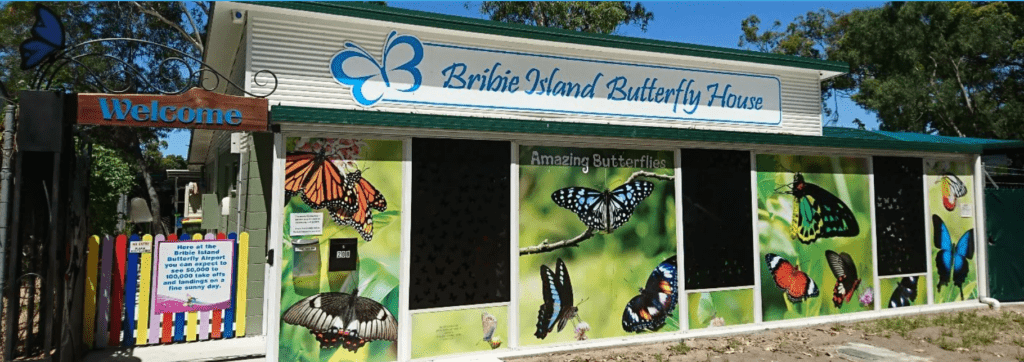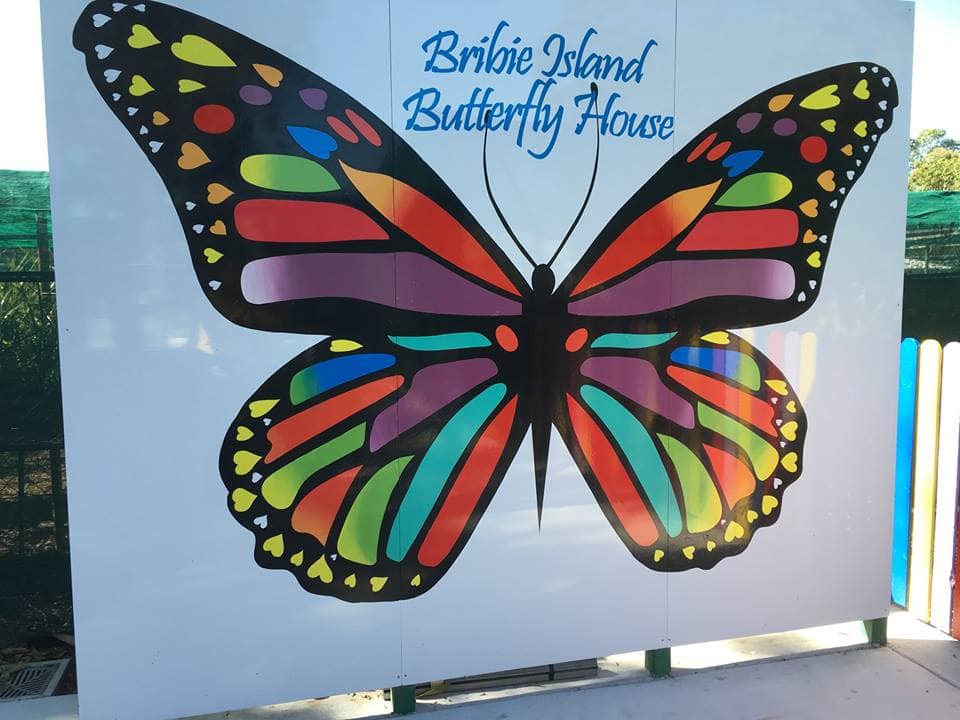Bribie Island Butterfly House offers families the unique opportunity to get up close and personal with some of Mother Nature’s most beautiful little treasures. Here’s what you need to know about taking a day trip and visiting this gorgeous spot with your family.
Bribie Island Butterfly House

Bribie Island Butterfly House is a volunteer-run organisation that looks to bring families and interested parties closer to nature.
It has been open since June 2017 and is open on Wednesdays and Sundays (including over the Christmas period) from 10am to 4pm. As this is a volunteer-run operation, you can understand why it’s just not possible to extend opening hours much more than that. However, in that short time, over 6000 people have been to visit!
Bribie Island Butterfly House is quickly establishing itself as a premium tourist destination on Bribie Island. It’s bringing the community together and encouraging those outside of it to visit and see the beauty that Bribie Island truly has to offer.
Where is Bribie Island Butterfly House?
Head to 208 First Avenue, Bribie Island. A number of Butterfly House signs will lead your way and the House itself is on the right-hand side, just past the sporting fields.
Entry costs for Bribie Island Butterfly House are as follows:
- Adults $12
- Concession / Students $10
- Pensioners /Children (4-15) $7
- Family (2 adults and 2 children) $34
You can also make your dollars stretch further by purchasing an Adult Annual Pass for $50 or a Family Annual Pass for $120.
Making the most of nature
It’s important for children to make connections with nature. This goes a long way to not only allowing them to have a lovely day out but also seeing that they appreciate wildlife and learn about conservation and sustainability. Having children visit places like Bribie Island Butterfly House allows them to see the hard work of concerned conservationists and the value that is placed on protecting vulnerable flora and fauna.
Is the Bribie Island Butterfly House good for kids?
Check it out in this video – we think so!
RELATED: Check out our reviews of Bongaree Beach and Woorim Beach on Bribie Island. They are perfect for kids.
How to attract butterflies to your garden
- Ditch the pesticides. This doesn’t mean you can’t do pest control in your garden, but certain pesticides, particularly malathion, Sevin, and diazinon, will kill butterflies. If you’re active with a neighbourhood council or community garden, mention this to the members as well. And why not take it a step further to help educate your community on safe pest control methods?
- Grow native plants. Growing native plants in your garden is akin to supporting your local farmers markets. It’s better for the planet, provides you with the easiest to care for crops, and it will support pollinators like butterflies and other local fauna that have evolved with the local flora.
- Keep the sun in mind. Even if you have just a small patch of land or a balcony, if it gets good sun, you could help support butterflies. There’s a reason we often associate butterflies with gorgeous sunny days; they typically only feed in full sun.
- Plant the right colors. Butterflies like bright colors. Think red, yellow, orange, pink and purple. And make sure the blossoms are flat-topped or have short flowering tubes.
- Plant the right milkweed. Monarchs only eat from the milkweed plant. But did you know that there are many types of milkweed? If you plant the wrong one for your region, it might not do monarchs any good.
- Create butterfly spas. Okay, so you don’t need to invest in a hot tub or sauna, but butterflies do require a little R&R, so why not invite them to do it in your yard? They prefer to rest in full sun, so nice flat rocks, tables or chairs for them to sun in will bring these gorgeous creatures to your yard. They also love puddling, which is basically hanging out in damp sand or mud where they drink a little water and mineralize. You can create specific puddling spots for the butterflies by filling shallow dishes or pans with sand and a bit of water and placing them in sunny spots in your yard.
- The Australian Butterfly Sanctuary recommends the following plants for common butterflies: (source)
Plant Species |
Butterflies |
| Acaias (wattles) A.flavescens, A.holoserica & A.melanoxylum | Some Jewel Butterflies; Tailed Emperor; Damels Blue; Ghost Moths, Eye Spot Moths; Large Leaf Moths as well as others |
| Lacewing Vine, Adenia heterophylla | Orange Cruiser; Red Glasswing; Orange Lacewing |
| Red Ash, Alphitonia excelsa | Fiery Jewel; Copper Jewel; Greenbanded Blue; Small Greenbanded Blue; Indigo Flash; Diggles Blue; Ghost Moths; Yellow Emperor Moth |
| Native Blue Fruited Ginger, Alpinia caerulea | Banded Demon |
| Soursop/Sweetsop annona muricata | Pale Green Triangle; Green Triangle; Green Triangle |
| Sugar Apple/Custard Apple Annona reticulata, A.squamosa | Green Spotted Triangle; Pale Green Triangle; Green Triangle; Blue Triangle; Common Red-eye |
| Native Dutchman’s Pipe Aristolochia tagala | Cairns Birdwing; Red-Bodied Swallowtail; Big Greasy |
| Native Dutchman’s Pipe Aristolochia thozetti | Big Greasy; Red-Bodied Swallowtail |
| Asystasia gangetica | Leafwing; Danaid Eggfly; Blue Banded Eggfly; Blue Argus |
| Flame Tree Brachychiton acerifolius | Common Aeroplane; Tailed Emperor; Helenita Blue |
| Coffee Bush Breynia oblongifolia | Australian Rustic; Grass Yellow |
| Bottlebrushes Callistemon spp | Nectar for butterflies; Ghost Moth; Emperor Gum Moth |
| Scented Myrtle Canthium coprosmoides | Hummingbird Hawk Moths |
| Sweet Scented Canthium Canthium odoratum | Hummingbird and Bumblebee Hawk Moths |
| Corky Bark Carallia biachiata | Four O’Clock Moth (day flying moth and beautifully coloured) |
| Slender Grape Cayratia clematidea | Harlequin Moth |
| Silky Celtis Tree Celtis paniculata | Australian Beak; Tailed Emperor |
| Common Celtis Celtis philippensis | Tailed Emperor; Macleays Blue Triangle; Purple Brown-eye; Common Red-eye |
| Oliver’s Laurel Cinnamomum oliveri | Blue Triangle |
| Citrus – esp grapefruit, lemon & lime trees | Orchard Butterfly; Dingy Swallowtail; Chequered Swallowtail; Ambrax; Hummingbird Moth; Emperor Moth |
| Brown Kurrajong Commersonia bartramia | Peacock Jewel |
| Northern Laurel Cryptocarya hyposyodia | Macleays Swallowtail; Blue Triangle; Common Oakblue |
| Darlingia darlingiana | Good source of nectar for most butterflies and moths |
| Climbing Derris Derris spp. trifoliata | Orange Aeroplane; Broad-Banded Awl |
| Hard Quandong Elaeocarpus obovaus | Fiery Jewel |
| Toywood Tree | Zodiac Moth, White Striped moth |
| Cherry Ballart Exocarpos cupressiformis, Native Cherry Exocarpos latifolius | Fiery Jewel; Crow butterflies; Foam Moths; Large Leaf Moth |
| October Glory Vine Faradaya splendida | Common Oakblue; Common Tit, Common Tailed Emperor; Pale Ciliate Blue; Eone Blue |
| Figs Ficus spp esp. F.racemosa;F.macrophylla | Crow butterflies; Common Moonbeam; Foam Moths |
| Buttonwood/Cheese Tree Glochidion spp.esp. G. ferdinandi, G. phillipicum | Common Oakblue; Hercules Moth; Ghost Moths |
| Ischnostemma carnosum (syn. Cynanchum carnosum) | Black & White Tiger; Lesser Wanderer; Blue Tiger; Common Crow |
| Brush Box Lophostemon conferta | Common Red-eye; Rare Regent Skipper; Fiery Jewel |
| Melaleuca spp. Mviridiflora, M.leucadendron & M.dealbata | Dull Oakblue; Common Oakblue; Ghost Moths: Flowers attract a range of butterflies |
| Melicope/Euodia spp. espM.elleryana; E.bonwickii | Ulysses butterfly; Ghost Moths; Emperor Moths |
| Mistletoes esp. Ameyma Dedrophthoe spp. | Northern Jezabel; Union Jack; Common Jezabel; Nysa Jezabel; Genoveva Azure; Purple Azure; Olane Azure; Dodds Azure; Cooktown Azure; Silky Azure; Amaryllis Azure; Narcissus Jewel; Diggles Blue; various Oakblues; Mistletoe Emperor Moths |
| Burny Bean Mucuna gigantea | Green Awl; Tailed Green Banded Blue |
| Ant Plant Myrmecodia beccarii | Apollo Jewel; Sphinx Hawk Moth |
| Booly Gum/White Bollywood Neolitsea Dealbata | Blue Triangle; Purple Brown-eye |
| Bleeding Heart Omalanthus novoguineensis | Hercules Moth |
| Day Moth Vine Omphalea queenslandiae | Zodia Moth |
| White Mulberry Pipturus argenteus | White Nymph |
| Cocy Apple Planchonia careya | Copper Jewel; Emperor Moth |
| Basswood Polyscias ssp | Hercules Moth |
| Pastel Flower Pseuderanthemum variabile | Blue Banded Eggfly; Common Daniad Eggfly; Leafwing; Blue Argus |
| Zig Zag Vine Rauwenhoffia leichardtii (syn. Melodorum leichardtii) | Four Bar Swordtail; Pale Green Triangle; Green Spotted Triangle |
| Brazil Red Bell Plant xRuellia tuberosa | Australian Lurcher |
| Gunstock Wood/Flintwood Scolopia braunii | Australian Rustic; Zebra Moth |
| Corky Milk Vine Secamone elliptica | Blue Tiger; Crow butterfly |
| Small Tetra Beech Tetrasynandra longipes | Regent Skipper |
| Damson/Almond Terminalia espT.muelleri | Common Oakblue; Narcisuss Jewel; Copper Jewel; Emperor Moth |
| Timonius timon | Hercules Moth; Emperor Moth |
| Wilkiea huegeliana & W.macrophylla | Regent skipper |
| Yellowood Zanthoxylum brachyacanthum | Orchard Butterfly; Ambrax; Capaneus |

